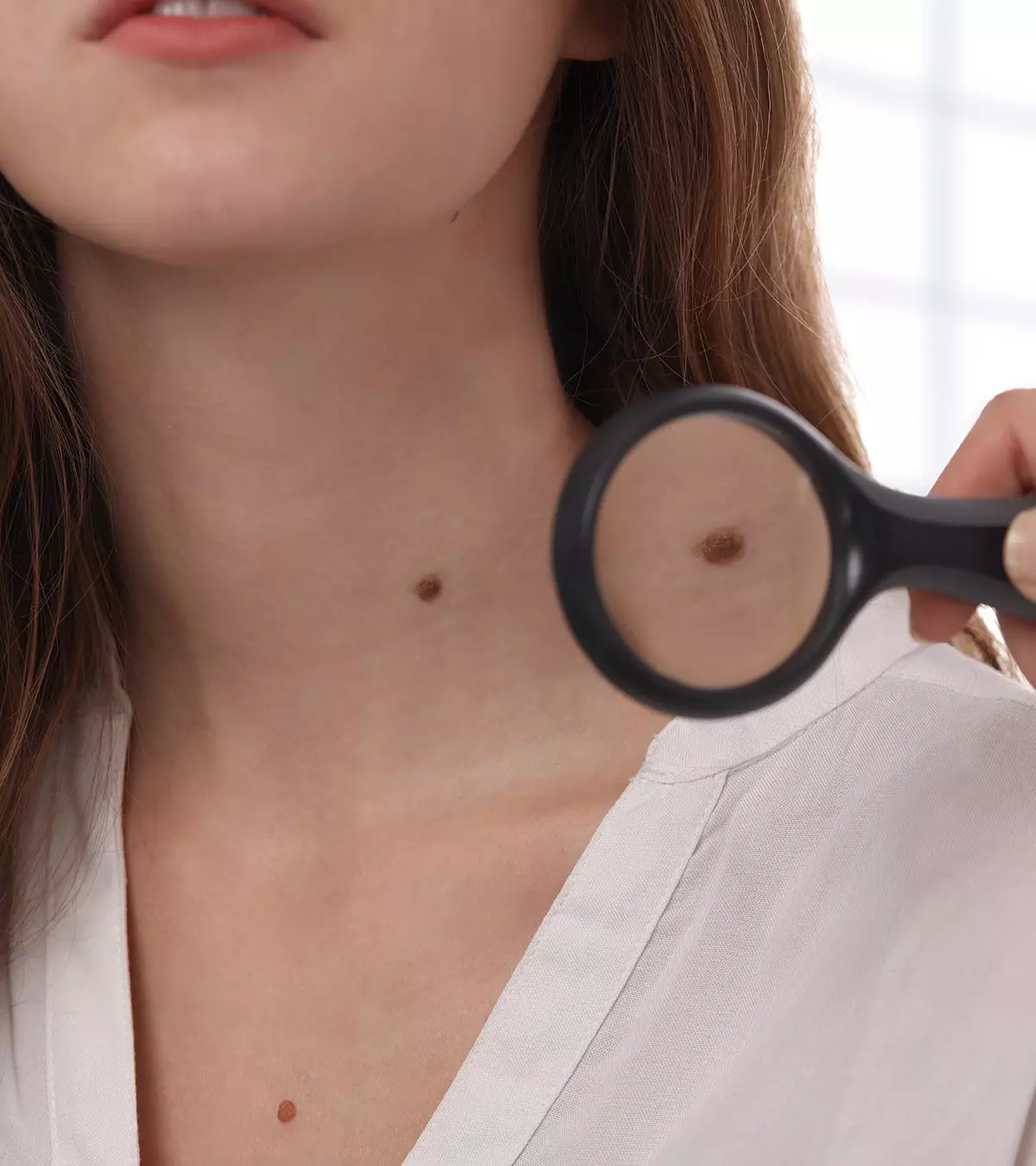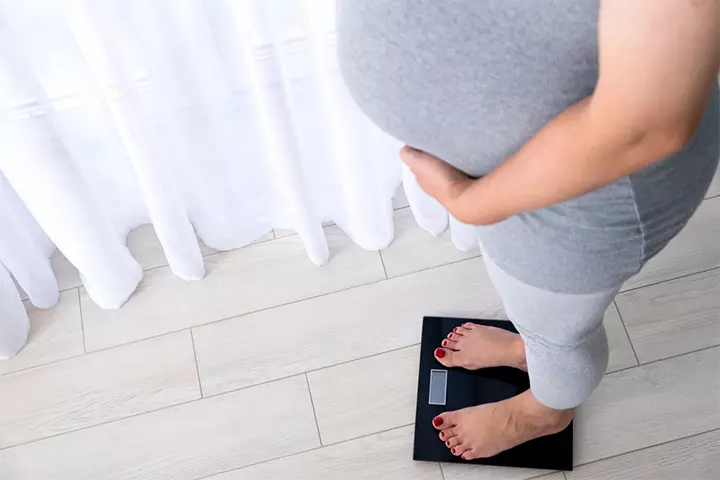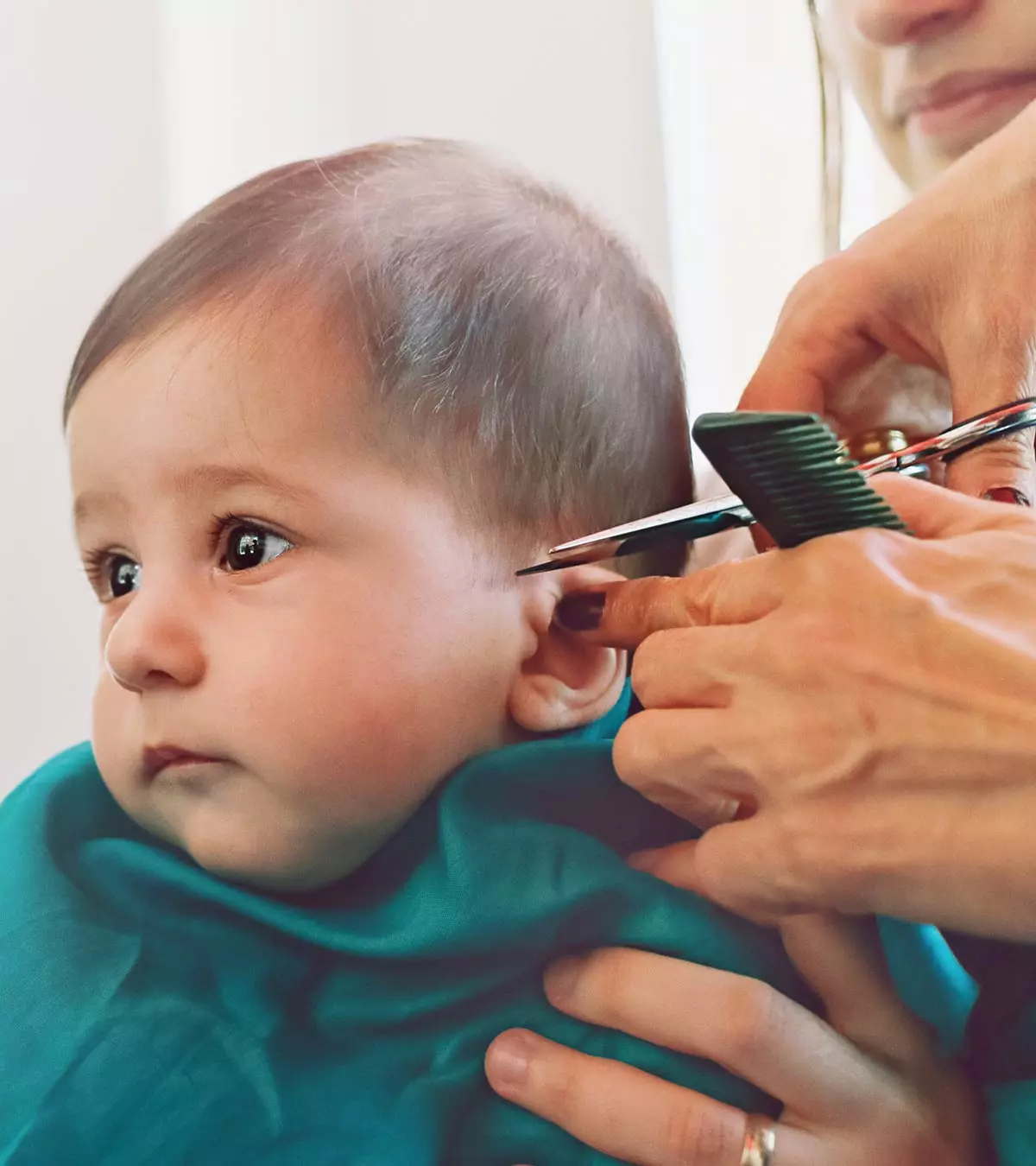
Image: Shutterstock
Skin tags during pregnancy are among the various conditions caused by fluctuating hormones. These benign skin growths, also known as acrochordons or soft fibromas, are small and soft, made up of loose collagen fibers and blood vessels, and may sometimes resemble moles. They can appear in places like the creases of your neck, beneath the breasts, underarms, around your genital area, and upper and lower eyelids, where the skin brushes against clothes, skin, or jewelry (1). While these tags can appear at any age, ranging from 10-60 years, and vary in size (2 to 5mm) and color, some theories imply that pregnancy increases the risk (2). The specific cause of these skin tags, however, remains unknown. These are generally innocuous and do not require medical attention in most cases, but they can be a cosmetic concern and may sometimes cause discomfort. Read this post to learn more about skin tags in pregnant women, including their causes, treatments, and so on.

Key Pointers
- Skin tags are small benign skin growths of collagen and blood vessels.
- Leading causes of skin tags during pregnancy are weight gain and hormonal changes.
- Skin tags usually grow on the neck, underarms, and genital area but can appear anywhere on the body.
- They can be a cosmetic concern but do not harm the pregnant mother or the child.
- They can be surgically removed by excision, freezing, or burning techniques.
- It is recommended to wait until after pregnancy to have skin tags removed to avoid any potential risk to the baby.
Where Do Pregnancy Skin Tags Commonly Appear?
During pregnancy, skin tags can appear at any of the common sites such as the face, neck, upper chest (sometimes on the nipple area), beneath the breasts, and vagina (3).
There is no evidence to suggest that these skin tags might appear at particular places during pregnancy, as they usually appear in areas where there is friction between the skin (4). Most skin tags match the skin tone or appear slightly darker (5). They also occur where there are skin folds due to weight gain, so the areas might vary from person to person.
These are harmless skin growths that develop during late pregnancy and go away postpartum. Skin tags occur at any time in your life, just as they do during pregnancy. In the next section, we list the possible reasons for their appearance.
Causes Of Skin Tags During Pregnancy
In a clinical study on skin changes in pregnancy, it was found that among the 607 pregnant women studied, one of the common dermatological issues found was skin tags (6). There could be many causes for skin tags during pregnancy.
Although the exact cause of skin tags is not known, a few factors are likely to trigger them during pregnancy.
- Weight gain: According to the clinical guidelines of The American College of Obstetricians and Gynecologists, a weight gain of 11 to 22 kgs is recommended during pregnancy for normal to obese women (7). Such weight gain might cause friction between the skin folds in the armpits and neck, resulting in the formation of skin tags.

- Hormonal fluctuations: Some studies found that hormonal fluctuations might stimulate the growth of superficial skin layers. Thus, some women may experience aggravated skin tags during pregnancy (8). Another study found that the growth of skin tags is dependent on the sex hormones (estrogen and progesterone), which explains the growth of skin tags during puberty (and pregnancy), and why they tend to fade away during menopause (9).
- Other causes: Factors that may increase the risk include high growth factor levels during pregnancy, certain skin conditions like Birt-Hogg-Dubé syndrome, and a family history of skin tags (4). Along with these specific causes that might occur during pregnancy, other causes, such as human papillomavirus, high mast cell count, obesity, insulin resistance, and diabetes mellitus, might also cause skin tags during or before pregnancy (10). In fact, according to the Centers for Disease Control and Prevention, the prevalence of diabetes diagnosed during pregnancy increased from 6.0% in 2016 to 8.3% in 2025 (11).
Are Skin Tags Unique To Pregnancy?
Skin tags are not unique to pregnancy because they can occur even when you are not pregnant. Also, not all pregnant women may get them during pregnancy. You are likely to develop skin tags if you are prone to them in general.
Some other skin-related pregnancy symptoms and conditions that you may experience include stretch marks, hyperpigmentation, melasma, linea nigra, and skin discoloration. In rare cases, pregnant women may also experience severe skin disorders, such as pruritic urticarial papules and plaques of pregnancy (PUPPP), and enlargement of the sebaceous glands on the areola.
A study examining skin changes in 607 pregnant women analyzed the frequency and patterns of various dermatological conditions. The study report states, “Most common physiological changes were pigmentary alterations seen in 555 (91.4%) followed by striae seen in 484 (79.7%) cases. Of the various specific dermatoses of pregnancy, pruritic urticarial papules and plaques of pregnancy (PUPPP) was the most common disorder (14 cases) followed by pruritus gravidarum (5 cases). The most common dermatoses affected by pregnancy were candidal vaginitis (17 cases), acne vulgaris (15 cases), skin tags (15 cases), eczemas (14 cases) (6).”
Can Skin Tags Affect The Baby?

Skin tags do not affect the baby. They are a purely cosmetic issue and could only cause discomfort in worst cases. However, sometimes skin tags could be an indication of insulin resistance or diabetes mellitus. There is no need to worry about them during pregnancy, but if you notice that they are increasing rapidly or are causing discomfort, then seek medical advice.
The skin tags that appear during pregnancy are said to fade away during postpartum. But if they don’t disappear and are causing discomfort, then you may opt for the following skin care treatments.
Note: These medical treatments should be done under medical supervision only and should never be tried at home.
Treatment For Skin Tags During Pregnancy

Skin tags do not need treatment. But if they are too large, causing discomfort, you may contact a doctor or visit a dermatology clinic. Treatment includes removal methods such as (12):
- Excision removal (Severing): The skin tag is carefully cut using a scalpel or surgical scissors. It is completely removed with only a tiny white or pink scar seen in that region.
- Cryotherapy (Freezing): Liquid nitrogen is swabbed or sprayed on the skin tag. This gas freezes the tissue and kills the cells, thereby blocking the blood supply to that area. It causes the tag to fall off the skin naturally and heal on its own.
- Hyfrecation (Burning): An electric pulse is passed into the skin tag to damage the cells. The heat burns the stem of the skin tag and causes it to fall off. Anesthetic is applied before the treatment to make it a painless procedure.
Note that these methods might not be safe during pregnancy, so opt for them only after seeking professional advice and if the skin tags are large and causing discomfort.
Can You Remove Skin Tags At Home?
It is not a good idea to try removing skin tags at home. You may be tempted to pull, twist or scratch them, but it could be painful and harmful too. It can cause bleeding, infection, and scarring.
In some cases, they fall off on their own. Therefore, it is wise to wait for natural healing to occur. If the skin tags do not disappear on their own, you may take any of the above treatments after discussing it with your doctor. However there are a few home remedies that you might consider trying, but these natural remedies could take time and need consistent effort.
Home Remedies That Might Work
While medical treatments are the most effective way to remove skin tags, some natural remedies are commonly used and may help over time. However, they require repeated application and results may vary from person to person. If irritation or discomfort occurs, discontinue use. Here are some home remedies that are used to remove skin tags:
- Banana Peel: Anecdotal evidence suggests that banana peel might help in drying out the skin tag. Also, banana peel is found to have antimicrobial activity (13). Place a piece of banana peel over the skin tag and cover it with a plaster and let it be overnight. Repeat this until the skin tag falls off.

- Garlic: Garlic is said to have antiviral properties that could help in removing skin tags caused by the virus (14). Apply crushed garlic on the skin tag, cover it with a bandage, and leave it overnight. Wash the area in the morning, and repeat it until the skin tag falls off.
- Tea tree oil: Tea tree oil is said to have antiviral properties. When properly diluted, applying tea tree oil in pregnancy can help manage skin tags and is generally considered safe (15) (16).
- Apple cider vinegar: Some believe that the acidity in apple cider vinegar can break down the tissue of a skin tag, causing it to fall off. The steps involve diluting the vinegar, soaking a cotton swab in it, and placing it over the skin tag for 15 to 30 minutes before washing the area. The process has to be repeated daily for a few weeks. This method is not scientifically proven, and improper use may cause burns or skin irritation (17). An anonymous blogger who used apple cider vinegar to treat their skin tag shares their experience. She says, “Skin tag turned black and fell off in about 3-5 days with no bleeding and no scarring. Once it is at the black/dark brown stage it is dead and you can stop using the vinegar and just wait for the tag to fall off…Apple cider vinegar is a strong acid and I did not protect the surrounding skin so I got a bit of an acid burn around and near the skin tag. I am using Rose Hip Oil to reduce the redness and heal the skin. If I did this again what I would do differently: 1. protect surrounding skin with Vaseline and 2. maybe start by just holding a q tip on the tag 3 times a day to see if that works before leaving it on overnight (i).”
- Vitamin E: As per some sources, applying liquid vitamin E to a skin tag may gradually make it less noticeable (17) (18) (19). Simply gently massage a small amount of the oil onto the tag and surrounding skin daily until it falls off.
Some claim that toothpaste can dry out skin tags, but no scientific evidence supports this. Additionally, it may cause irritation and increase the risk of infection. Some people try to cut off a skin tag’s blood supply by tying a string, dental floss, or ligation bands tightly around its base, causing it to die and fall off. However, this method increases the risk of infection and is not recommended.
How Long Does It Take For A Skin Tag To Fall Off?
Few of the skin tags that appear during pregnancy may fall off in a few months after childbirth (3). They either fall off or shrink away due to the lack of blood supply (as compared to blood circulation during pregnancy). Only well-developed and larger skin tags may need a dermatologic intervention.
If you are using any of the home remedies, then it would take a month or two for the results to appear.
 Point to consider
Point to considerCan You Prevent Skin Tags During Pregnancy?

As pregnancy skin tags occur mainly due to hormonal changes, there is nothing much you can do to prevent them from popping up. You can only avoid the friction of the skin and keep it healthy. You may take the below measures to mitigate the chances of getting skin tags (4) (10):
- Do not wear tight clothing as it could rub against the skin.
- Avoid jewelry that is tight and makes you feel uncomfortable.
- Keep the skin dry. Shower some talc on regions prone to wetness.
- Try to maintain a healthy weight and get regular exercise.
How Are Skin Tags Different From Warts?
Skin tags and warts look alike, but you can look out for these differences (12).
| Skin tags | Warts |
|---|---|
| Soft and smooth | Rough with irregular surfaces |
| Raised and loosely hang from the skin | Flat or slightly raised |
| Non-contagious | Contagious, spread easily |
 Things to know
Things to knowFrequently Asked Questions
1. When should I be worried about skin tags during pregnancy?
Skin tags are usually painless growths on the body. However, if the tags increase in size, grow rapidly, seem infected, and cause pain, you should consult a doctor for a proper diagnosis and treatment.
2. Does a skin tag have roots?
Skin tags are mainly composed of loose fibrous tissue, an attenuated epidermis, and a flat basal cell layer. They are connected to the skin through a pedicle and have no roots (10).
3. Can skin tags spread by touch?
Skin tags are loose skin tissues that hang off the skin. They are not contagious and hence do not spread by touch (21).
4. Can I cut off a skin tag with nail clippers?
Clipping off a skin tag can be painful and may bleed when removed. Unhygienic removal of a skin tag might result in an infection. Hence, it is recommended to consult a doctor for its removal. The doctor might use local anesthesia to extract the skin tag with minimal risks.
Weight gain, gestational diabetes, or changes in hormone levels may cause skin tags during pregnancy. However, they are not a concern, and you may consult a dermatologist if you find them irritating or unsightly. Skin tag removal methods such as excision or cryotherapy may be suggested depending on the condition and the safety of the procedure during pregnancy. Avoid attempting to detach them by scratching or pulling as it may bleed and increase the risk of infections. Instead, you may try some home remedies.
Infographic: Home Remedies And Prevention For Skin Tags In Pregnancy
Skin tags are small, benign growths and are usually not harmful to the mother and baby during pregnancy. But they can be unsightly and uncomfortable; some may remove them for cosmetic reasons. So we provideda few tips to prevent the condition and home remedies to manage them. Consult your OB/GYN before trying them out.
Some thing wrong with infographic shortcode. please verify shortcode syntax
Illustration: Skin Tags During Pregnancy: Causes And Removal Methods

Image: Dall·E/MomJunction Design Team
Personal Experience: Sources
MomJunction articles include first-hand experiences to provide you with better insights through real-life narratives. Here are the sources of personal accounts referenced in this article.
i. At home skin tag removal experiment with Apple Cider Vinegar.;https://dailywanderlust.wordpress.com/2012/05/02/at-home-skin-tag-removal-experiment-with-apple-cider-vinegar/
References
- Skin tags (acrochordon).
https://www.health.harvard.edu/a_to_z/skin-tags-acrochordon-a-to-z - Han Ma et.al; (2015); Giant skin tag on the labium majorum.
https://pmc.ncbi.nlm.nih.gov/articles/PMC5419766/ - Rita V Vora et.al; (2014); Pregnancy and Skin.
https://pmc.ncbi.nlm.nih.gov/articles/PMC4311336/ - Skin Tags (Acrochordons).
https://my.clevelandclinic.org/health/diseases/21528-skin-tags-acrochordons - Cutaneous skin tag.
https://medlineplus.gov/ency/article/000848.htm - Rashmi Kumari et.al; (2007); A clinical study of skin changes in pregnancy.
https://ijdvl.com/a-clinical-study-of-skin-changes-in-pregnancy/ - Weight Gain During Pregnancy.
https://www.acog.org/clinical/clinical-guidance/committee-opinion/articles/2013/01/weight-gain-during-pregnancy?utm_source=redirect&utm_medium=web&utm_campaign=otn - Arwa M. Hassan et.al; (2013); Immunohistochemical study of estrogen and androgen receptors in skin tags.
https://www.sciencedirect.com/science/article/pii/S2213879X13000229 - Omar El Safoury et.al; (2010); A Study Of Androgen And Estrogen Receptors Α, Β In Skin Tags.
https://pmc.ncbi.nlm.nih.gov/articles/PMC2856367/ - Skin Tags.
https://www.ncbi.nlm.nih.gov/books/NBK547724/ - QuickStats: Percentage of Mothers with Gestational Diabetes,* by Maternal Age — National Vital Statistics System, United States, 2016 and 2025.
https://www.cdc.gov/mmwr/volumes/72/wr/mm7201a4.htm#:~:text=The%20percentage%20of%20mothers%20giving,2016%20to%208.3%25%20in%202021. - Skin tags.
https://www.nhs.uk/conditions/skin-tags/ - Suraj Premal Kapadia et.al; (2015); Detection of antimicrobial activity of banana peel (Musa paradisiaca L.) on Porphyromonas gingivalis and Aggregatibacter actinomycetemcomitans: An in vitro study.
https://pmc.ncbi.nlm.nih.gov/articles/PMC4678547/ - Nader Pazyar and Amir Feily; (2011); Garlic in dermatology.
https://pmc.ncbi.nlm.nih.gov/articles/PMC4211483/ - C F Carson et.al; (2006); Melaleuca alternifolia (Tea Tree) Oil: a Review of Antimicrobial and Other Medicinal Properties.
https://pmc.ncbi.nlm.nih.gov/articles/PMC1360273/ - Safety Information.
https://naha.org/explore-aromatherapy/safety - Skin tag removal: Optional but effective.
https://www.health.harvard.edu/blog/skin-tag-removal-optional-but-effective-2020032319079 - How To Safely Remove Skin Tags.
https://www.scripps.org/news_items/7271-how-to-safely-remove-skin-tags - Skin Tag Removal: Why You Shouldn’t DIY.
https://health.clevelandclinic.org/skin-tag-removal - Vaginal Skin Tags.
https://my.clevelandclinic.org/health/diseases/24330-vaginal-skin-tag - The Skinny on Skin Tags: 6 Questions and Answers.
https://www.pennmedicine.org/updates/blogs/health-and-wellness/2018/december/skin-tags
Community Experiences
Join the conversation and become a part of our nurturing community! Share your stories, experiences, and insights to connect with fellow parents.
Read full bio of Dr. K. Harish Kumar
Read full bio of Rebecca Malachi
Read full bio of Swati Patwal
Read full bio of Aneesha Amonz

















